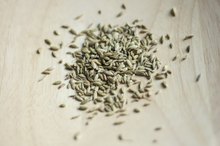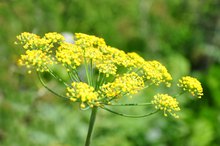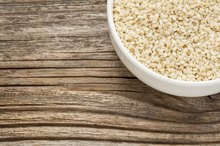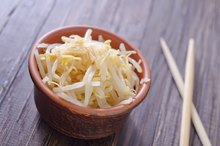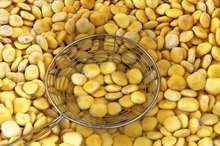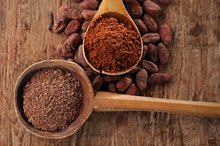What does fact checked mean?
At Healthfully, we strive to deliver objective content that is accurate and up-to-date. Our team periodically reviews articles in order to ensure content quality. The sources cited below consist of evidence from peer-reviewed journals, prominent medical organizations, academic associations, and government data.
- Linus Pauling Institute: Iron
- Linus Pauling Institute: Magnesium
- Linus Pauling Institute: Manganese
- Linus Pauling Institute: Calcium
The information contained on this site is for informational purposes only, and should not be used as a substitute for the advice of a professional health care provider. Please check with the appropriate physician regarding health questions and concerns. Although we strive to deliver accurate and up-to-date information, no guarantee to that effect is made.
Anise Seeds Vs. Fennel Seeds
For lifelong health, stock your pantry with herbs and spices. The University of Michigan Health System recommends using seasonings in place of sugar and fat to help you lose weight and promote cardiovascular health by reducing your sodium intake. The spices fennel and anise lend licoricelike flavor to your meals, can season a range of dishes -- from meats to vegetables and baked goods -- and contain negligible amounts of sodium. Using them in your cooking boosts your food's nutritional value, although the seeds differ slightly in their nutrient content.
Basic Nutrition Information
Both anise and fennel seeds contribute only a small amount to your daily calorie intake 2. A 2-tablespoon serving of anise contains just 45 calories, while an equivalent serving of fennel seeds contain 40 calories. Anise and fennel offer a small amount of protein -- roughly 2 grams per serving -- and also contain approximately 2 grams of fat. Both seeds' fat content comes primarily from unsaturated fats -- the healthy fatty acids associated with a lower risk of cardiovascular disease.
- Both anise and fennel seeds contribute only a small amount to your daily calorie intake 2.
- Anise and fennel offer a small amount of protein -- roughly 2 grams per serving -- and also contain approximately 2 grams of fat.
Fiber Content
Fennel Seeds for High Blood Pressure
Learn More
Anise and fennel seeds offer some dietary fiber, though fennel serves as the healthier choice if you're looking to boost your fiber intake. Each 2-tablespoon serving of fennel seed contains 4.6 grams of dietary fiber -- about 18 percent of the recommended daily intake for women and 12 percent for men. Anise offers significantly less fiber, at 2 grams per serving. Eat meals rich in fiber to fight constipation -- you don't break down fiber during digestion, so it bulks up your stool and keeps you regular.
- Anise and fennel seeds offer some dietary fiber, though fennel serves as the healthier choice if you're looking to boost your fiber intake.
Iron and Magnesium Content
Fennel offers more magnesium but less iron than anise 24. Both minerals play central roles in your health -- iron helps carry fresh oxygen to your cells and tissues, while magnesium proves important for muscle function. A serving of fennel offers 45 milligrams of magnesium -- 11 percent of the daily magnesium needs for men and 14 percent for women -- while anise contains just 23 milligrams per serving. On the other hand, one serving of anise supplies 5 milligrams of iron -- 28 percent of the daily requirements for women and 63 percent for men -- while fennel contains just 2.2 milligrams.
- Fennel offers more magnesium but less iron than anise 2.
- A serving of fennel offers 45 milligrams of magnesium -- 11 percent of the daily magnesium needs for men and 14 percent for women -- while anise contains just 23 milligrams per serving.
Manganese and Calcium
Are Raw Peanuts Good for You?
Learn More
Fennel offers significantly more manganese and calcium per serving than anise. These minerals promote skeletal health because manganese activates enzymes essential for cartilage and bone development, while calcium gets incorporated into new bone tissue. A serving of fennel seed offers 139 milligrams of calcium, or 14 percent of your daily needs, while anise contains 87 milligrams. Fennel also boasts 758 micrograms of manganese -- an impressive 33 and 42 percent of the daily manganese needs for men and women, respectively -- compared to anise's 308 micrograms.
- Fennel offers significantly more manganese and calcium per serving than anise.
- A serving of fennel seed offers 139 milligrams of calcium, or 14 percent of your daily needs, while anise contains 87 milligrams.
Related Articles
References
- UDSA National Nutrient Database: Spices, Anise Seed
- UDSA National Nutrient Database: Spices, Fennel Seed
- Linus Pauling Institute: Iron
- Linus Pauling Institute: Magnesium
- Linus Pauling Institute: Manganese
- Linus Pauling Institute: Calcium
- U.S. Department of Agriculture. FoodData Central. Fennel, bulb, raw. 2019.
- Badgujar SB, Patel VV, Bandivdekar AH. Foeniculum vulgare Mill: A Review of Its Botany, Phytochemistry, Pharmacology, Contemporary Application, and Toxicology. Biomed Res Int. 2014;2014:842674. doi:10.1155/2014/842674
- Shahat AA, Ibrahim AY, Hendawy SF, et al. Chemical Composition, Antimicrobial and Antioxidant Activities of Essential Oils from Organically Cultivated Fennel Cultivars. Molecules. 2011;16(2):1366-1377. doi:10.3390/molecules16021366
- Swathi V, Rekha R, Abhishek J, Radha G, Pallavi SK, Praveen G. Effect of Chewing Fennel and Cardamom Seeds on Dental Plaque and Salivary pH – A Randomized Controlled Trial. Int J Pharm Sci Res. 2016;7(1):406-412. doi:10.13040/IJPSR.0975-8232.7
- National Institutes of Health. Office of Dietary Supplements. Vitamin C Fact Sheet for Health Professionals. Updated February 27, 2020.
- Di Ciaula A, Portincasa P, Maes N, Albert A. Efficacy of bio-optimized extracts of turmeric and essential fennel oil on the quality of life in patients with irritable bowel syndrome. Ann Gastroenterol. 2018;31(6):685-691. doi:10.20524/aog.2018.0304
- American Academy of Allergy Asthma and Immunology. Can spices cause allergic reactions? 2020.
- Allergy & ENT Specialists of Central Florida. Fennel. Updated 2015.
- Berkeley Wellness. University of California. Fennel: The Flavor of Sweet Anise. 2016.
- Centers for Disease Control and Prevention. Fruit and Vegetable Safety. Updated February 12, 2020.
Writer Bio
Sylvie Tremblay holds a Master of Science in molecular and cellular biology and has years of experience as a cancer researcher and neuroscientist.
